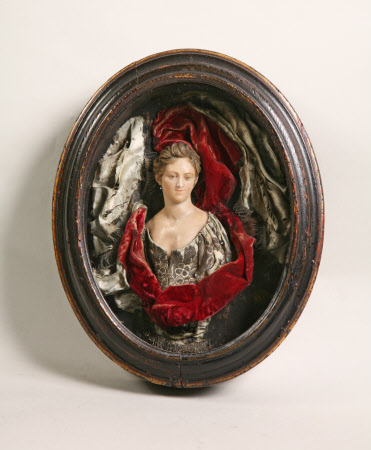Portrait of a woman
British (English) School
Category
Art / Sculpture
Date
c. 1800
Materials
Wax, fabric, wood
Measurements
305 x 260 mm
Place of origin
Great Britain
Order this imageCollection
Treasurer's House, North Yorkshire
NT 592790.1
Caption
Emerging from the background in high relief, these miniature portraits of a man and a woman seem, rather uncannily, to inhabit their frames. They are modelled in coloured wax in lifelike detail, their bodies swathed in swags of silk and velvet to enhance the illusion. Made in the late 18th or early 19th century, the sitters are unidentified, but the style of their dress and hairdos, particularly the man’s wig, dates from around 1720, suggesting that the portraits may have been made from images rather than from life. Wax was a favoured medium for anatomical models, sculptural reliefs and portrait miniatures. It was inexpensive, easy to mould and could be used to model finely detailed forms. Polychrome wax likenesses were particularly popular from the late 18th century among middle and upper classes alike, and several women artists had successful careers as wax portraitists. An example by the popular wax sculptor Samuel Percy (1750–1820) survives at The Argory, County Armagh (NT 564569), with an inscription suggesting that the portrait should be viewed parallel to a window so that the subject’s features are enhanced ‘by Light and Shadow’.
Summary
Wax, fabric, wood, Portrait of a woman, British (English) School, c. 1800. One of a pair of polychrome wax portrait figures of a man and a woman wearing early eighteenth-century fashion, the figures swathed in coloured velvets and silks. The woman wears an embroidered grey gown, her brown hair loosely pinned up into a chignon. Swathed in red velvet. In wooden oval frame.
Provenance
Given by Frank Green (1861-1954) along with house, garden and contents to the National Trust in 1930
Makers and roles
British (English) School, sculptor
